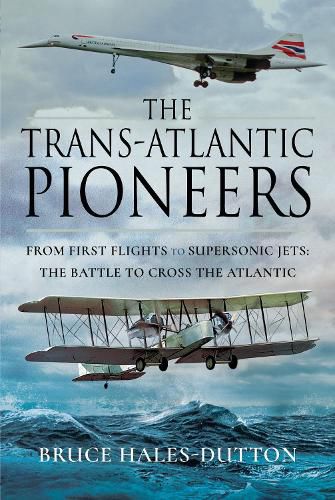Readings Newsletter
Become a Readings Member to make your shopping experience even easier.
Sign in or sign up for free!
You’re not far away from qualifying for FREE standard shipping within Australia
You’ve qualified for FREE standard shipping within Australia
The cart is loading…






Every day up to 3,000 aircraft fly across the Atlantic Ocean. If each one carries 250 passengers, that could mean as many as 750,000 people on the move between Europe and North America. The main concern for most is the choice of in-flight movie or whether to have beef or chicken for dinner. A century ago it was very different. Before John Alcock and Arthur Whitten Brown’s epic flight of June 1919 no such journey had been attempted and they could not know what to expect. Of course, it took all the guts and determination the two men could muster but there was something else. Alcock and Brown were true professionals. Both had thought very deeply about the challenges facing them and both were determined to leave nothing to chance. In the background was the GBP10,000 prize offered by Lord Northcliffe, whose generosity represented a potent incentive for pioneer aviators. Inevitably, the names of Alcock and Brown have become synonymous with that first trans-Atlantic flight. They were the first but by no means the last of the trans-Atlantic pioneers. AUTHOR: Newspaper and magazine journalist, government press officer and aviation industry public relations specialist, BRUCE HALES-DUTTON’s professional career has encompassed all of these. He has worked for the government department responsible for the aviation industry, a major international airports group and a highly-respected supplier of air traffic control services as well as Britain’s aviation industry regulator. During this time, he has written text for articles, news releases, brochures and leaflets, scripts for video programmes and speeches. He now concentrates on writing books and articles about his two great loves, aviation and motor racing. Bruce is a member of the Royal Aeronautical Society and a volunteer steward at Brooklands Museum. He was born in Kent and continues to live there.
16 b/w illustrations
$9.00 standard shipping within Australia
FREE standard shipping within Australia for orders over $100.00
Express & International shipping calculated at checkout
Every day up to 3,000 aircraft fly across the Atlantic Ocean. If each one carries 250 passengers, that could mean as many as 750,000 people on the move between Europe and North America. The main concern for most is the choice of in-flight movie or whether to have beef or chicken for dinner. A century ago it was very different. Before John Alcock and Arthur Whitten Brown’s epic flight of June 1919 no such journey had been attempted and they could not know what to expect. Of course, it took all the guts and determination the two men could muster but there was something else. Alcock and Brown were true professionals. Both had thought very deeply about the challenges facing them and both were determined to leave nothing to chance. In the background was the GBP10,000 prize offered by Lord Northcliffe, whose generosity represented a potent incentive for pioneer aviators. Inevitably, the names of Alcock and Brown have become synonymous with that first trans-Atlantic flight. They were the first but by no means the last of the trans-Atlantic pioneers. AUTHOR: Newspaper and magazine journalist, government press officer and aviation industry public relations specialist, BRUCE HALES-DUTTON’s professional career has encompassed all of these. He has worked for the government department responsible for the aviation industry, a major international airports group and a highly-respected supplier of air traffic control services as well as Britain’s aviation industry regulator. During this time, he has written text for articles, news releases, brochures and leaflets, scripts for video programmes and speeches. He now concentrates on writing books and articles about his two great loves, aviation and motor racing. Bruce is a member of the Royal Aeronautical Society and a volunteer steward at Brooklands Museum. He was born in Kent and continues to live there.
16 b/w illustrations